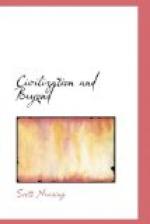In east central Europe and around the Mediterranean the beginnings of western civilization had made their appearance and were expanding their control along the Eurasian trade routes and beginning to penetrate western and northern Europe. The Crusades had introduced Asian culture traits into the European backwoods. Hardy European and Asian mariners were penetrating the Americas. Dark ages of ignorance and superstition which had held sway in Europe for centuries were coming to an end. Western civilization was beginning to draw the breath of a new life.
The vast structure of Roman civilization had split West from East. The Eastern Empire retained its form and continued its culture for centuries after its break with the West. Meanwhile the West fragmented into smaller and smaller units, increasingly self-contained and increasingly isolated. Cities raised and manned their own walls. The countryside broke up into smaller and smaller divisions over which the Holy Roman Empire exercised little more than a shadowy authority. Each landed estate had its stronghold or castle. Each locality looked after its own interests. The massive Roman Universal State, stretching for centuries across parts of three continents, had broken up into a multitude of tiny semi-sovereign, semi-independent fragments. Some of the fragments as leagues, alliances and coalitions were reaching nationhood.
New dawn was illuminating the Dark Ages. Western man was sorting and re-assembling some of the scattered fragments of the defunct and dismembered Roman civilization. The task was colossal. Rome’s “one authority, one law, one language” hegemony had been replaced by an all pervading diversity. The closely knit Greco-Roman Empire had been superseded in Europe by a sparsely inhabited, roadless wilderness, largely bereft of trade, using waterways as the easiest means of communication and transport. The economy was built around wood cutting, charcoal burning, backward animal husbandry, hand-tool agriculture, hand-craft industry, the rudiments of commerce and finance centered in trading cities. The great houses of the aristocracy and the gentry, scattered villages, towns and walled cities were preoccupied and disrupted by endless feuding and between-seasons warfare.
Adding to the chaos of this dismembered society were the controversies over dynastic succession. Intermittent incursions of migrating hordes from central Asia pushed their way into central and southern Europe. Covert and open conflicts between ecclesiastical and secular authority added to the general lethargy, confusion and chaos.
Europe struggled for centuries to free itself from Asian invasion and occupation. At the same time Europe was improving its agriculture, restoring its trade and expanding its hand-craft industries and its commerce. Towns grew in population and productivity. Life-standards rose in the cities. Cities based on trade and commerce extended their authority and became city-states. Commercial cities joined their forces to form trading leagues.




